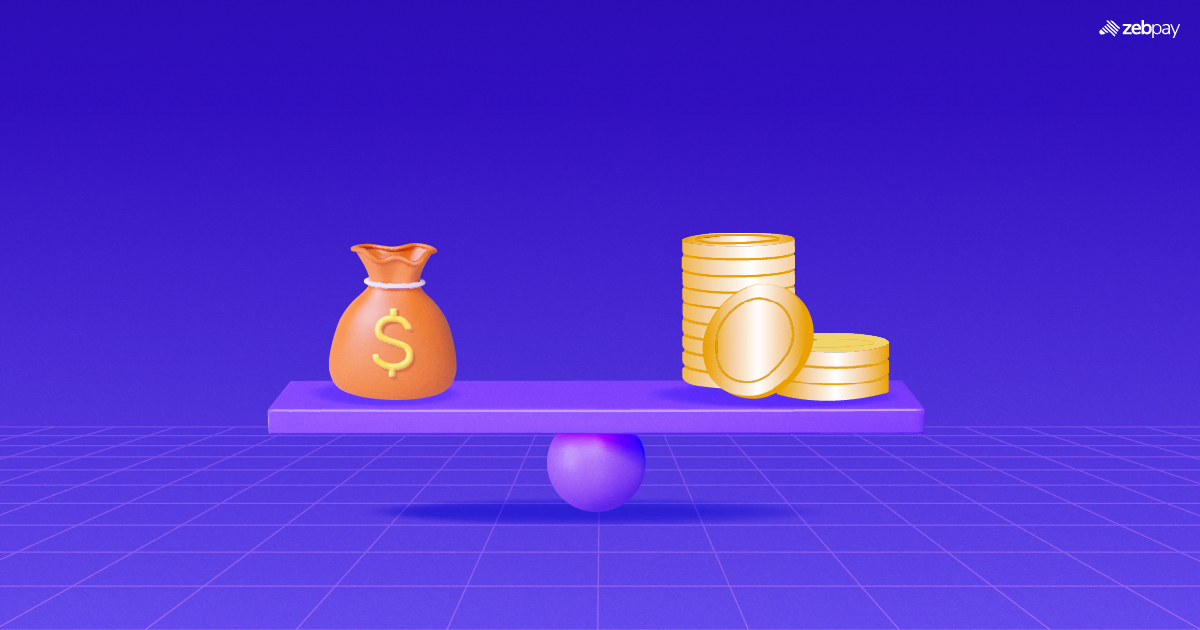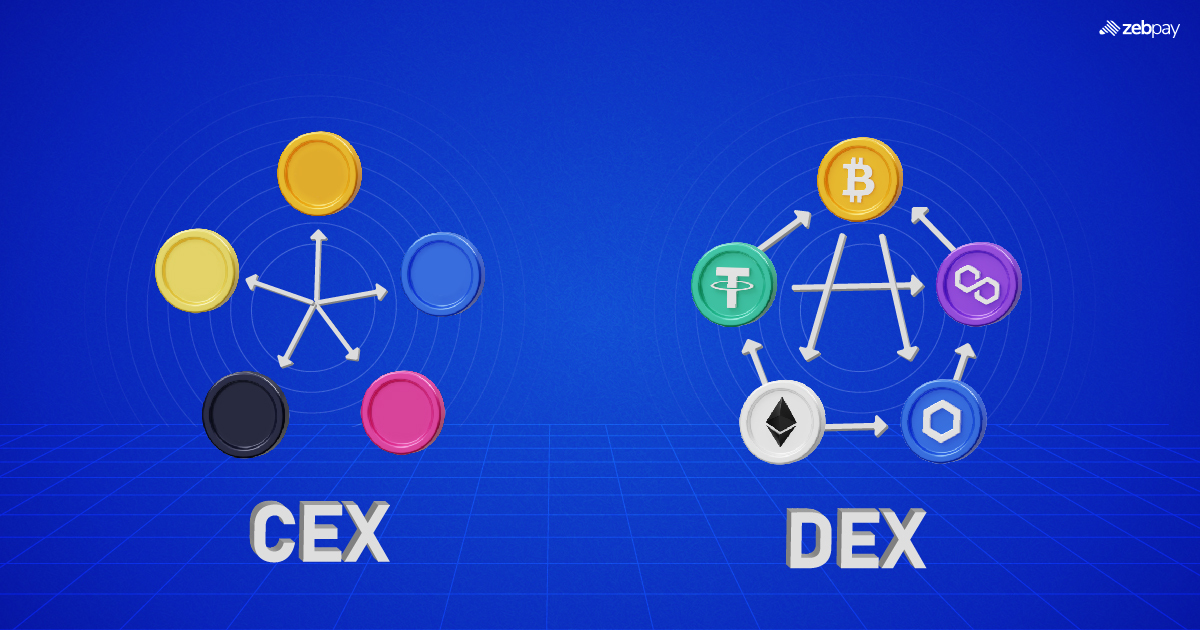What are Stable Coins?
Stablecoins are crypto assets pegged to match a financial asset or currency like the US Dollar or gold. True to their name, the values of these tokens are relatively stable. These are very popular among people. Following are different types of stablecoins.
Algorithmic Stablecoins
Algorithmic stablecoins employ algorithms and smart contracts to regulate the issuance of tokens. When the price of the stablecoin falls below the value of the fiat currency it is pegged to, the system will decrease the token supply through mechanisms such as burning or buybacks. Conversely, if the price exceeds the fiat currency value, additional tokens are introduced into circulation to stabilise the stablecoin’s value.
Crypto-backed Stablecoins
Stablecoins backed by crypto assets utilise other digital assets as collateral and employ smart contracts to oversee the minting and burning of the stablecoin. This is intended to make the process more trustworthy since users can independently audit the contracts. Certain crypto-backed stablecoins are managed by Decentralised Autonomous Organisations (DAOs), allowing the community to participate in decision-making through voting mechanisms.
Fiat-backed Stablecoins
Fiat-backed stablecoins employ official government currency such as the U.S. dollar as backing. Individuals can exchange between fiat and stablecoin at the designated pegged rate. When the token’s value drops below the supporting fiat currency, investors can utilise arbitration techniques to restore the value to a predetermined rate. This involves the simultaneous buying and selling of the same asset across various markets.
Read more: Fiat Vs Crypto
Snapshot of Top 10 Stable Coins
| Coin name | Market Cap |
| Tether( USDT) | $105 billion |
| USDC (USDC) | $32 billion |
| DAI (DAI) | $5.3 billion |
| First Digital USD (FDUSD) | $2.5 billion |
| Ethena USDe | $1.8 billion |
| USDD (USDD) | $726 million |
| Frax (FRAX) | $647 million |
| True USD (TUSD) | $494 million |
| Paypal USD (PYUSD) | $190 million |
| Pax Dollar (USDP) | $147 million |
Top 10 Best Stablecoins: Explained
Tether (USDT)
Tether (USDT) stands as one of the earliest stablecoins in circulation and is often considered a vital force within the crypto ecosystem. Tether extends its stablecoin offerings beyond the U.S. dollar, with variants pegged to alternative fiat currencies like the euro (EURt), Mexican peso (MXNt), and Chinese yuan (CNHt). Additionally, it offers a token backed by tangible gold, recognised as Tether Gold (XAUt).
Read more: USDT vs USDC
USD Coin (USDC)
USD Coin (USDC) is another token pegged to the US dollar. In 2018, a consortium named Centre, established by fintech leaders Circle and Coinbase, introduced it. USDC can be swiftly sent and received via Circle or various crypto exchanges, and seamlessly integrated into applications and decentralised applications (dApps) as a payment option.
DAI
DAI, operating on the Ethereum blockchain, aims to maintain a stable value relative to the U.S. dollar through algorithmic mechanisms. Unlike centralised stablecoins, DAI is not supported by U.S. currency held in a bank account. Instead, it is backed by collateral within the MakerDAO platform, a decentralised autonomous organisation functioning on the Ethereum network. This setup enables individuals to engage in crypto lending and borrowing. In the event of an upgrade or closure of the Dai credit system, holders may be required to convert their DAI to Ethereum crypto via the Maker platform.
Read more: What is DAI
First Digital USD (FDUSD)
First Digital USD (FDUSD) is a USD-backed stablecoin. It is known to reduce the transaction costs and improve the speed and efficiency in a secure environment. This is accomplished by carefully verifying that the worth of the reserve assets aligns with or surpasses the total amount of stablecoins in circulation. Essentially, these reserves act as a safeguard, assuring the issuer’s dedication to redeeming the stablecoin at its face value.
Ethena USDe (USDe)
Ethena, operating as a synthetic dollar protocol on the Ethereum blockchain, aims to offer a crypto-native monetary solution independent of traditional banking systems. It introduces USDe, a censorship-resistant, scalable, and stable synthetic dollar achieved through delta-hedging staked Ethereum collateral. USDe will be transparently fully backed on-chain, allowing for composability across DeFi platforms.
USDD (USDD)
USDD, a stablecoin released by the TRON DAO Reserve, is tethered to the U.S. dollar’s value and is designed to offer a dependable, decentralised digital asset for blockchain activities. USDD serves various purposes such as facilitating payments, trading, staking, and acting as a store of value.
Read more: What is crypto staking
The stability and security of USDD are supported by a variety of cryptos like Bitcoin, Ethereum, and TRON. To guarantee stability and safety, the reserve is over-collateralised, ensuring that it possesses more assets than the current circulating supply of USDD.
Frax (FRAX)
The Frax Protocol represents the inaugural fractional-algorithmic stablecoin system, characterised by its open-source, permissionless, and fully on-chain operation, currently implemented on Ethereum, with potential cross-chain implementations in the future. The ultimate objective of the Frax protocol is to establish a highly scalable, decentralized, algorithmic money system as an alternative to fixed-supply digital assets, such as Bitcoin.
True USD (TUSD)
TUSD is the pioneering digital asset with real-time on-chain attestations from independent third-party entities, maintaining a 1:1 backing with the U.S. dollar. It has been listed on over 100 trading platforms, including Binance and Huobi, and is currently active on 12 prominent public chains, such as Ethereum, TRON, Avalanche, BSC, Fantom, and Polygon.
Paypal USD (PYUSD)
For over two decades, PayPal has been a trailblazer in the digital payment revolution, utilising technology to enhance the accessibility, affordability, and security of financial services and commerce. The PayPal platform has enabled hundreds of millions of consumers and merchants across over 200 markets to actively participate in and benefit from the global economy.
Pax Dollar(USDP)
Established in September 2018, Pax Dollar is a stablecoin backed by collateral to stabilise its price. Pax Dollar was founded by Charles Cascarilla and Rich Teo. It is a stablecoin operating on the Ethereum blockchain with a 1:1 ratio of US Dollars present in the Paxos owned backed bank accounts.
Please note that this blog is not an investment recommendation. Investors are required to conduct their thorough due diligence before deciding to invest in any crypto-related asset.
If you found this blog to be useful, do share it with other like-minded crypto enthusiasts. Click on the button below to begin your crypto trading journey using ZebPay.







